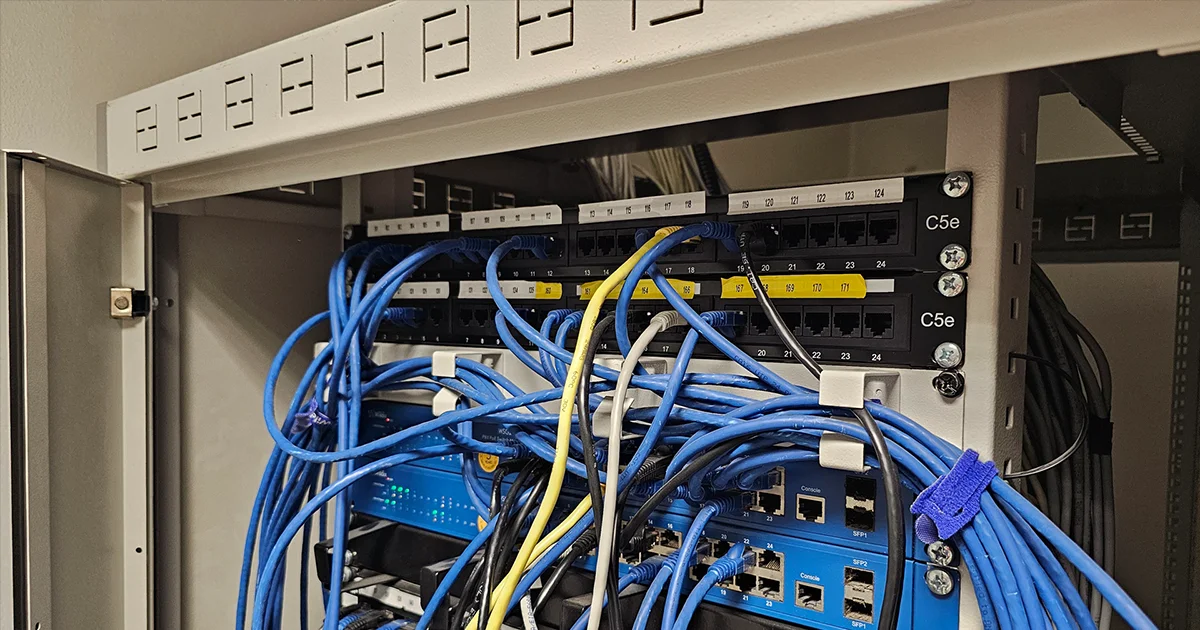
What Is Your Phone System?
It’s more than just your phones. It’s every system you use for real-time communications — whether it’s video, live chat or … well … your phone. It can be the phone on your desk or the one you carry around in your pocket (if it’s got a base station, that is, where it recharges). Ultimately, it’s everything controlled by what’s called a PBX, a private branch exchange. This divides up your phone lines and lets you have multiple phones in your business.
Now, the concept of a phone system is more nebulous — it doesn’t have to involve a physical phone. Phones can be physical or they can be software-based, accessible on your computer or your mobile phone.
Damage Stacks Up
Old-style phone systems, such as those by Avaya, Toshiba, NEC, Panasonic or Samsung, often require physical hardware, which slowly degrades. The reason they degrade is because:
- Small power surges damage circuits.
- Dust and debris causes and clogs fans.
- Thermal issues result in expanding/contracting metal.
- Printed circuit boards become brittle and fail.
There’s rarely one big event that causes failures. Instead, its capabilities slowly drop, slowing it down.
Worse, as these systems age, they’re often having to do more with the limited capabilities they have. If you have an old Windows XP computer around, for example, you’ll find that it just can’t run much modern software anymore, and that’s because hardware requirements have dramatically increased over the past 20 years. The same applies to your hardware PBX, the private branch exchange that’s at the center of your phone system.
It’s also really inefficient to have physical servers and hardware around. They are a single point of failure when it comes to your business, and if one part of the system fails, the whole thing goes down. That’s not ideal.
If you’ve noticed power failures, outages, slowdowns or calls that cut out, it’s time to change your phone system.
Tired of paying for dying hardware? Book a demo and see how cloud communications eliminates maintenance nightmares.
It Can’t Do What You Need It To Do
Like other parts of your business, your phone system must provide a benefit. It’s no longer enough to simply have a phone number. Instead, you need to be able to communicate on all channels — voice, video and text. That’s because people often want to see those they’re talking to, and we have this ability now.
But it goes beyond that — your phone system (really your communications system) must be unified with other aspects of your business. And you can do that easily with modern solutions.
This unification means that when someone calls you, you can access your booking system or perhaps you can call people directly from your customer database. It’s not just unifying voice and video. It’s trying to unify as much as possible — all the software you use.
You could click a button on your customer relationship management software, and it immediately dials out to the customer. Or you could add a doorphone or entryway device to your phone system. Perhaps you want to have better recording and call management from a single place. Even system monitoring!
So much is an absolute hassle to do with a physical PBX system, especially one from 10 or 20 years ago.
You need a full communications system that works for you — one that makes your life easier.
It’s Becoming Expensive
Maintaining legacy systems isn’t really a science. It’s become an art form. Unfortunately, artists require paying, and they know you need to be able to call people.
Legacy systems will always be expensive, and much of that cost comes from trying to secure them. Layering on VPNs, SBCs, additional security layers and patches whenever they update often requires human intervention — and that costs money.
Worse, some PBX systems aren’t receiving updates anymore because they’re end of life. That makes your insurance more expensive, especially as insurers are becoming more aware of the cost of cyber attacks. If you don’t have a compliant system, your insurance will either be very expensive or you won’t be covered.
Even having to swap out an SAS hard drive on a legacy server costs money and time, money that could be better spent on more profitable aspects of your business.
All this results in continuous running costs for something that you’ve already paid a lot of money for.
Is Unified Communications the Answer?
Unified communications is simply a new way of creating communications systems, one that unifies all the parts involved. It allows companies to integrate their systems into each other to speed up essential business processes, and it makes it simple to do more.
By that, we mean all these little efficiencies add up.
Athens County in Georgia found they saved up to an hour a day per employee through improved efficiencies and better functions — just being able to instantly look up people and dial saved them a lot of time. This means they’re spending less time on simple administrative tasks and more time serving the community — something they couldn’t do on their old Avaya system.
For them, a unified communications system changed how they worked, allowing remote work if needed and a hybrid working model if preferred. In addition, it gave people business numbers for use on their phones.
The upgraded system made it easier to do what they needed it to do. And that’s the beauty of unified communications.
1 hour more productivity per employee, every day. That’s what Athens County achieved. Book your demo and see your potential.